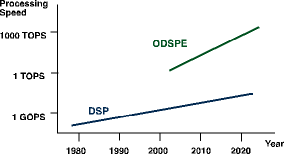Lenslet Labs announces new optics-based DSP technology
27 February 2002
DSP, Micros & Memory
Lenslet Labs, an Israeli company, has unveiled the world's first commercial optics-based digital signal processing technology, following a successful technology demonstration.
Lenslet’s optical digital signal processing engine converts electrical signals to optical signals (forward conversion)and the reverse (back conversion). Forward conversion (the sources array) can operate at a speed of 1 giga vectors per second while the ‘Back conversion (using photo detector array) can operate at even higher speeds
This technology boosts the performance of digital signal processing in a single component, setting new performance levels of Tera operations per second. The technology is based on a proprietary optical core that takes multiple electronic digital inputs, converts them into optical signals (photons), performs the desired computation at light speed in the optical core, and then converts the optical output signals back into digital electronic form. The company has taken advantage of new optical components that have appeared on the market in recent years, as well as breakthrough proprietary signal conditioning algorithms.
Lenslet's Optical Digital Signal Processing Engine (ODSPE) reaches Tera (1012) Operations Per Second (TOPS) and, according to the company, has the potential of reaching hundreds of TOPS in the foreseeable future, surpassing current DSP speeds that are measured in hundreds and thousands of Mega (106) Operations Per Second (MOPS).
The proprietory optical core achieves a performance equivalent to 8 Tera MAC operations per second, with a performance of hundreds of TOPs expected in the forseeable future
Unlike traditional DSPs, the ODSPE uses mathematical transforms rather than instructions as its basic atomic operations. This greatly accelerates software development time by mapping computation-intensive algorithms onto the ODSPE at a conceptually higher level of abstraction. Lenslet's ODSPE is re-configurable and can be dynamically tailored to the required transform type. Lenslet says it provides on-the-fly programmability, flexibility and upgradeability.
"Lenslet has been successful in leveraging optical technologies originally developed for optical transmission and switching, and applying them to optical computing using a unique algorithmic approach," said Aviram Sariel, Founder and CEO of Lenslet Labs.
"It is a very rare occasion when I can say that a company has a breakthrough technology, but Lenslet appears to have just that," said Will Strauss, President of Forward Concepts, a market research firm that specialises in DSP technology.
Lenslet Labs is headquartered in Ramat Gan, Israel, and employs over 40 professionals, most of them scientists and engineers with advanced degrees.
For further information contact Ron Levy, Lenslet Labs, (0972) 3 753 8410, [email protected]
Further reading:
Memory for asset tracking
Altron Arrow
DSP, Micros & Memory
The Page EEPROM, ST’s latest memory, has been designed for efficient datalogging and fast firmware upload/download in battery-operated devices.
Read more...
Engineered for high-reliability applications
Future Electronics
DSP, Micros & Memory
The MCX E series of Arm Cortex-M4F and Arm Cortex-M7 microcontrollers from NXP are engineered for demanding industrial and IoT environments.
Read more...
NXP’s development platform guide
DSP, Micros & Memory
Choosing between the FRDM i.MX 93, FRDM i.MX 91 and FRDM i.MX 91S development platforms can be intimidating, but once designers understand how each platform aligns with their application’s requirements, the decision becomes straightforward.
Read more...
XJTAG launches two new Flash programmers
ASIC Design Services
DSP, Micros & Memory
XJTAG has announced XJExpress and XJExpress-FPGA, a pair of Flash programmers perfect for development, debug and in-service applications.
Read more...
Processor offers competitive solution for advanced HMIs
Future Electronics
DSP, Micros & Memory
The new RZ/A3M microprocessor from Renesas features 128 Mbytes of fast DDR3L DRAM memory for system cost reduction, and supports
1280 x 800 px video resolution at a rate of 30 frames/s.
Read more...
ESP32-C6 achieves PSA-L2
iCorp Technologies
DSP, Micros & Memory
Espressif Systems recently announced that its ESP32-C6 microcontroller has achieved PSA Certified Level 2 (PSA-L2) security certification, making it the first RISC-V-based MCU to reach this level.
Read more...
Microprocessor with integrated NPU
Avnet Silica
DSP, Micros & Memory
The RZ/G3E from Renesas is a microprocessor integrated with quad CPU and NPU in one chip, improving power efficiency, reliability, and security.
Read more...
Nordic Semiconductor launches nRF Connect SDK Bare Metal option for nRF54L series
Avnet Silica
DSP, Micros & Memory
This is a new, RTOS-independent software solution for Bluetooth LE development, designed to ease developers’ migration from the legacy nRF5 SDK and nRF52 series to the next-generation nRF54L series.
Read more...
Dual-core support in NECTO Studio
DSP, Micros & Memory
MIKROE recently announced that version 7.3.0 of its NECTO Studio Integrated Development Environment now supports dual-core MCUs, allowing designers to program and debug each core independently.
Read more...
Post Quantum Cryptographic firmware library
DSP, Micros & Memory
The STM32 post-quantum cryptographic library enables developers to satisfy application requirements for any combination of data integrity, confidentiality, identification/authentication, and nonrepudiation.
Read more...



